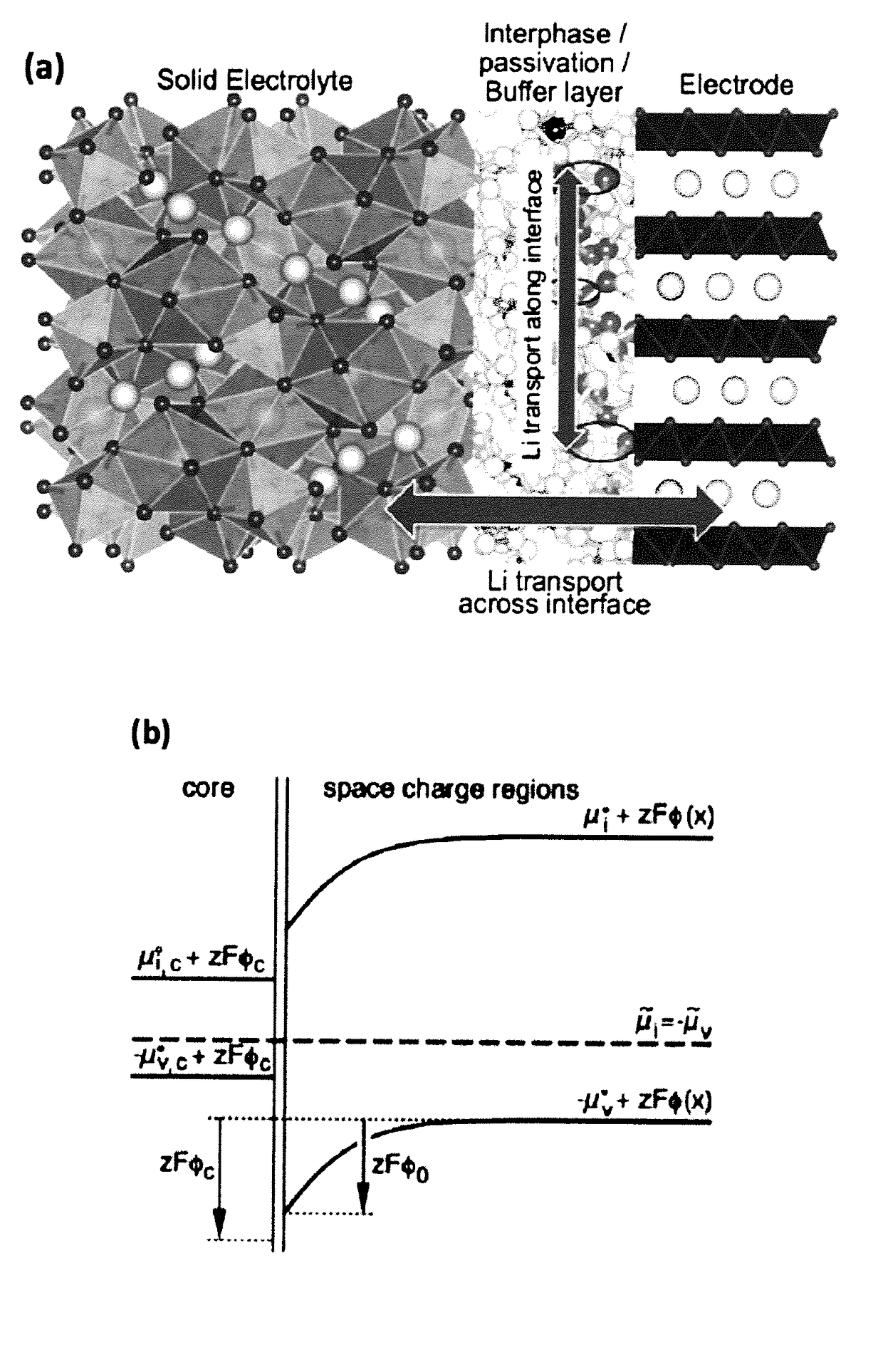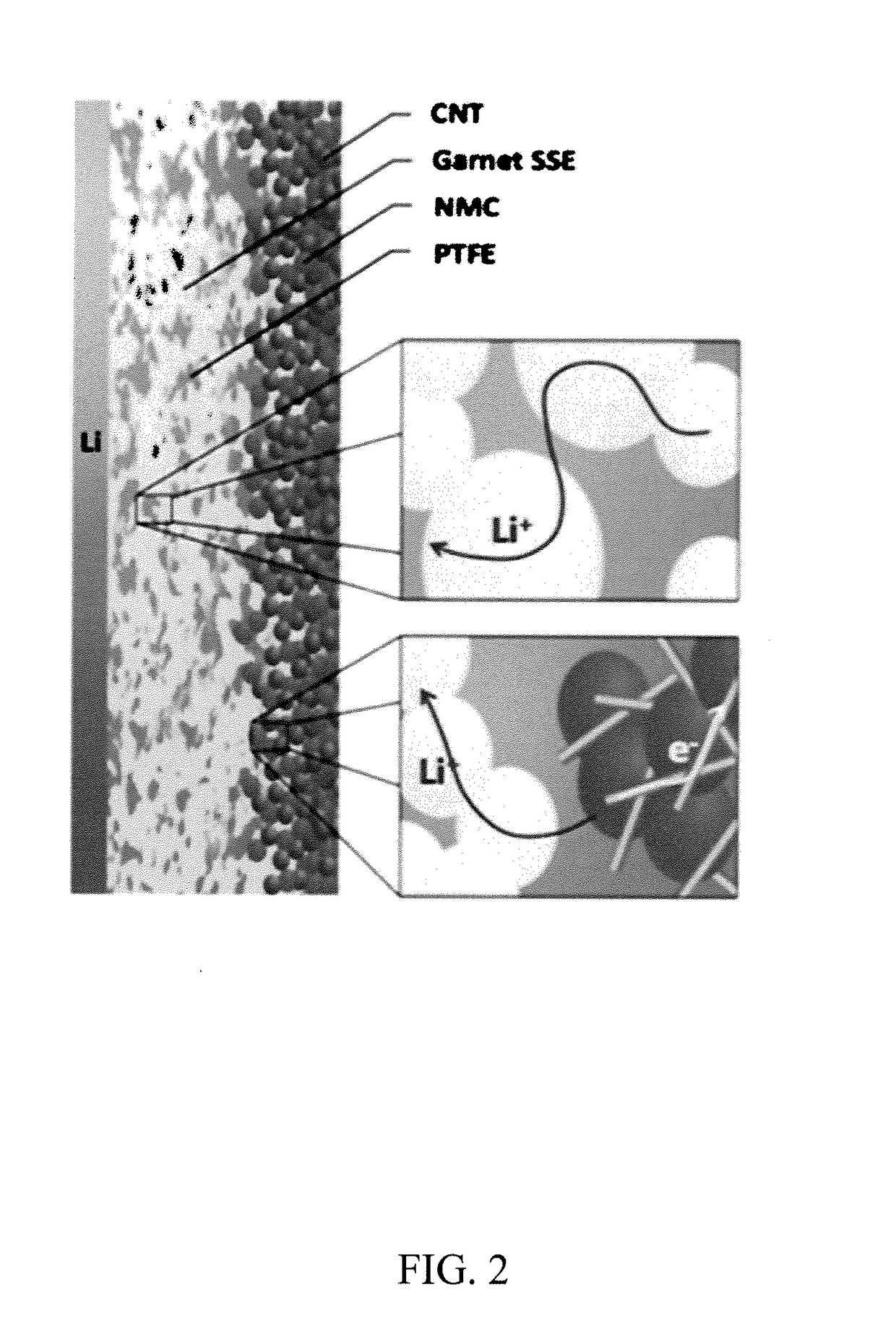Interfacial layers for solid-state batteries and methods of making same
a solid-state battery and interfacial layer technology, applied in secondary cells, battery service/maintenance, cell components, etc., can solve the problems of sulfide-based glass electrolytes that are not stable against metallic li, the interface at the anode side is rarely explored, and the successful demonstration of high-performance sslibs with garnet sse is not easy to achiev
- Summary
- Abstract
- Description
- Claims
- Application Information
AI Technical Summary
Benefits of technology
Problems solved by technology
Method used
Image
Examples
example 1
[0072]The following example provides an example of the fabrication of interfacial layers of the present disclosure.
[0073]The large interfacial impedance between lithium metal anode and the garnet electrolyte was addressed using ultrathin aluminum oxide (Al2O3) by atomic layer deposition (ALD). Li7La2.75Ca0.25Zr1.75Nb0.25O12 (LLCZN) is used as the garnet material due to increased lithium ion conductivity. A 300-fold decrease of DC interfacial impedance, from 606 Ω·cm2 to 2 Ω·cm2, was observed at room temperature, effectively negating the lithium-metal / garnet interfacial impedance. Experimental and computational results reveal that the oxide coating enables wetting of metallic lithium in contact with the garnet electrolyte surface and the lithiated-alumina interface allows effective lithium ion transport between the lithium metal anode and garnet electrolyte. A working cell with lithium metal anode, garnet electrolyte and a high voltage cathode was demonstrated by applying the interfa...
example 2
[0089]The following example provides an example of the fabrication of interfacial layers of the present disclosure.
[0090]This example focuses on garnet-based SSEs, but it is expected that the knowledge be applicable to other SSE chemistries. In order to get low interfacial impedance solid state batteries, it may be desirable to address the following technical barriers:
Large interfacial impedance for charge transfer and transport; and
Mechanical degradation of interface with electrochemical charge / discharge cycles.
[0091]The interface EIS of garnet and LFMO electrode was characterized. It was found that structures on the surface of garnet pellet reduce the interface impedance. A PFPE nonflammable solvent was prepared, and PFPE / LiTFSI electrolyte was tested and found to be electrochemically stable in the voltage region of 0-4.2 volts (v). PVDF-HFP gel membrane was prepared, and the stability and impedance of ionic liquid electrolyte in gel membrane tested.
[0092]Characterization of Elect...
example 3
[0106]The following example provides an example of the fabrication of interfacial layers of the present disclosure.
[0107]Based on the interface engineering methods disclosed herein, a SSLiB was successfully designed and operated using Li metal anode, garnet electrolyte and a high-voltage cathode. This structure has different interfacial layers for the anode (a metal oxide) and the cathode (polymer / ion-conducting liquid). Electrical properties of the structure are shown in FIG. 11.
[0108]Synthesis of Li2FeMn3O8 (LFMO). LFMO was synthesized according to the literature with modification. Briefly, glycine-nitrate mixture solution was firstly prepared by dissolving lithium nitrate, iron nitrate, manganese nitrate (2:1:3, mole ratio) and glycine in de-ionized water. The mole ratio of nitrate to glycine is 2:1. Then, the LFMO powder was obtained by combustion reaction of the glycine-nitrate solution at 300° C., followed with a 2-hour annealing at 700° C.
[0109]Battery assembly and electroche...
PUM
 Login to View More
Login to View More Abstract
Description
Claims
Application Information
 Login to View More
Login to View More - R&D
- Intellectual Property
- Life Sciences
- Materials
- Tech Scout
- Unparalleled Data Quality
- Higher Quality Content
- 60% Fewer Hallucinations
Browse by: Latest US Patents, China's latest patents, Technical Efficacy Thesaurus, Application Domain, Technology Topic, Popular Technical Reports.
© 2025 PatSnap. All rights reserved.Legal|Privacy policy|Modern Slavery Act Transparency Statement|Sitemap|About US| Contact US: help@patsnap.com



